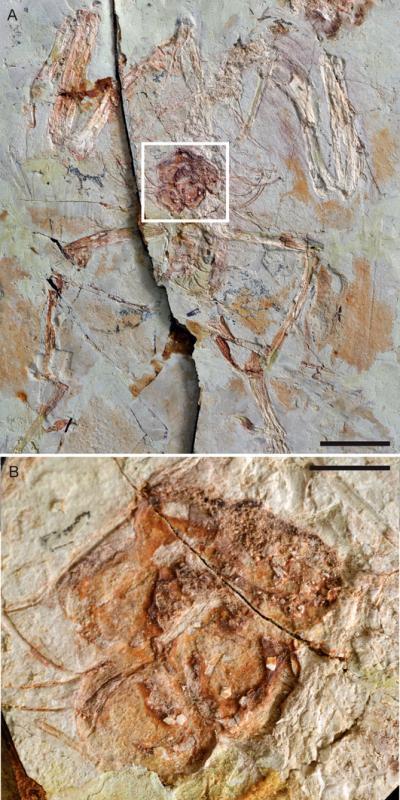As winged dinosaurs underwent a series of evolutionary changes during the transition into Aves, or birds, one pivotal transformation was the appearance of a single-ovary reproductive system. "The most widely accepted hypothesis for the presence of a single functional ovary in living birds is that the right ovary … was lost to reduce body mass in gravid females during flight," report a team of Chinese scientists who are adding new details to the mosaic of understanding how terrestrial dinosaurs gave rise to birds and powered flight.
These scientists, led by the director of the prestigious Institute of Vertebrate Paleontology and Paleoanthropology in Beijing, posit that this adaptation of the reproductive system likely occurred "gradually during the evolution of dinosaurs and basal birds," yet add that until recently, the fossil record provided only scattered evidence on the timeline of these phylogenetic changes.
But the discovery of a series of fossils that include evidence of single ovaries in the basal bird Jeholornis and in an array of more derived enantiornithine birds from the Cretaceous, in what is now eastern China, is helping them pinpoint the timing of the pared-down reproductive system of avian dinosaurs.
Members of Aves, which includes the common ancestor of the 150 million-year-old Archaeopteryx and all living birds, are unique among amniotes in terms of featuring a single-ovary system, notes Zhonghe Zhou, director of the IVPP and lead author of the study "Ovarian follicles shed new light on dinosaur reproduction during the transition towards birds."
One feathered dinosaur considered closely related to birds, the oviraptorosaurian maniraptoran theropod, had two functional ovaries, according to Zhou and co-authors of the paper.
In contrast, they add, the fossil of the primitive bird Jeholornis that was recently uncovered in the northeastern Chinese province of Liaoning featured the lighter-weight single ovary system. "Jeholornis," they explain, "with its long dinosaurian boney tail, is only slightly more derived than Archaeopteryx, indicating that even the most basal birds were already modern in this aspect."
This provides evidence that the evolution in the reproductive structure "occurred at — or very near — the dinosaur–avian transition, supporting the hypothesis that birds lost the use of [one] ovary due to the energetic pressures of flight," Zhou and colleagues state.

(A) This is the new specimen of Enantiornithes indet (STM10󈝸) preserving ovarian follicles, note the specimen is preserved in dorsal view and the follicles are preserved on the left side of the body, scale bar equals 20 mm. (B) Closeup of the follicles (enlarged from white box in A), scale bar equals 5 mm.
(Photo Credit: ©Science China Press)
Zhonghe Zhou and IVPP scholar Jingmai K. O'Connor, along with Xiaoting Zheng, Xiaoli Wang, and Yan Wang of the Institute of Geology and Paleontology at Linyi University, in the eastern Chinese province of Shandong, presented their findings in a study published by the just-launched journal National Science Review.
The National Science Review is the first comprehensive scholarly journal published in English in China that is aimed at linking the country's rapidly advancing community of scientists with the global frontiers of science and technology. The journal also aims to shine a worldwide spotlight on scientific research advances across China.
Zhonghe Zhou and the Institute of Vertebrate Paleontology and Paleoanthropology, which is part of the Chinese Academy of Sciences, have long been at the forefront of characterizing the remarkable winged dinosaurs that are being uncovered across China.
Following the discovery of microscopic evidence of feather coloring and patterns in dinosaur and bird fossils dating back to the late Jurassic, the IVPP set out to begin depicting these species in living color. The finding of melanosomes, or pigment-bearing organelles, embedded in the fossil feathers of select dinosaur specimens unexpectedly provided a means to reconstruct a wide array of feathered dinosaurs with a scientifically precise palette, Zhou said in an earlier interview with EurekAlert!.
The examination of a sampling of dinosaur fossils from the Early Cretaceous Jehol Biota and the Jurassic Yanliao Biota (dating back about 160 million years) using a scanning electron microscope uncovered the color-triggering melanosomes. The discovery, Zhou said, could enable the reconstruction across a full-color spectrum of dinosaurs featuring pennaceous feathers resembling the flight feathers of modern birds. Studies have already involved Sinosauropteryx, the dromaeosaurid Microraptor gui and the Jurassic Anchiornis. They could also extend to more dinosaurs and other vertebrates such as mammals, pterosaurs, and lizards.
In the new study published in the National Science Review, the Chinese scientists also report that the number of ovary follicles discovered in Aves specimens tended to decrease over the course of evolution, with Jeholornis featuring 20 eggs and some fossils of enantiornithine birds, which became extinct, along with non-avian dinosaurs, at the end of the Cretaceous 66 million years ago, carrying only 5-6 follicles.
This decrease likely reflects "a broad trend toward more K-selected life history strategies," they posit in the paper. "This trend toward more K-selected lifestyles continues into Neornithes, in parallel to the Cretaceous radiation of enantiornithines," they explain.
Zhonghe Zhou says the new paper chronicles progress made following a previous report in Nature, while adding some new specimens. "It is also notable," he says, "that we are looking for more fossil evidence of follicles in birds and hopefully more information will be revealed in the future."
Source: Science China Press